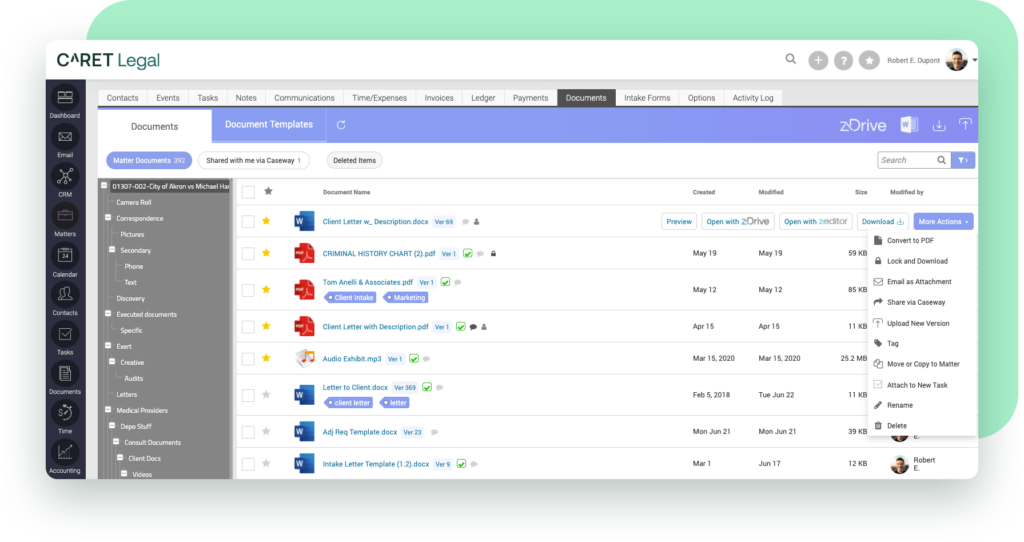Effective document management ensures that both physical and digital documents are easy to locate and access when needed.
Handling legal documents efficiently isn’t just about staying organized – it’s about maintaining productivity, minimizing errors, and ensuring compliance. With the vast amount of contracts, case files, and other legal documents circulating within a firm, disorganized document management can quickly lead to costly mistakes.
To avoid these pitfalls, law firms have the option to adopt legal practice management software (LPMS) with tailored document capabilities. This guide provides actionable insights and tools to help law firms improve document storage, accessibility, and compliance, transforming how to manage critical information.
Understanding the Basics of Legal Document Management
Legal document management refers to the process of organizing, storing, and retrieving the various types of legal documents a firm handles daily. These documents can include contracts, case files, correspondence, and court filings. Effective document management ensures that both physical and digital documents are easy to locate and access when needed.
Both digital and physical document storage for law firms play a vital role in managing legal information. While many firms are moving toward fully digital systems, a hybrid approach is often necessary to handle legacy paper files effectively. A well-organized law firm document management strategy will encompass both digital and paper documents.
Choosing the Right Tools with the Right Document Management Features
Selecting a LPMS with the right document management tools is crucial for law firms seeking to improve organization and maintain security. Essential features to look for in a system include:
- Version control: Ensures that teams work on the most current document versions while maintaining a history of edits.
- Search functionality: Allows for quick retrieval of documents based on keywords, clients, or case numbers.
- Document automation: Streamlines the creation and filing of documents, reducing manual errors.
- Audit trails: Tracks who accessed or modified a document, providing accountability and compliance.
Cloud-based document management: Allows for secure remote access, making collaboration across teams easier and more efficient.

Setting Up a Clear Folder Structure and Naming Conventions
One of the most effective ways to manage legal documents is to establish a clear and consistent folder structure. This makes sure that documents are logically grouped, making it easier to locate and retrieve files later. Creating folders by client, matter, and document type can help in achieving this.
Additionally, standardized naming conventions help to avoid misfiling and confusion. For instance, naming documents with a combination of client name, case number, and document type makes them easily searchable. By implementing these organizational strategies, firms can prevent misfiling and simplify future document retrieval, reducing time wasted searching for documents.
Implementing Document Security and Access Controls
Security is a top priority when managing legal documents containing sensitive client data. Implementing role-based access controls ensures that only authorized personnel can view, edit, or share specific documents. Document management systems should also include encryption for sensitive files, providing an additional layer of security.
Modern legal document management platforms also offer features that track document access and modifications, adding accountability. This tracking allows firms to see who accessed or edited a document and when adding another layer of compliance and control. Implementing these security measures is essential for protecting client confidentiality and maintaining trust.

Ensuring Compliance with Legal Regulations
Compliance with legal regulations is a significant concern for law firms – protecting sensitive data and client confidentiality is non-negotiable. A robust LPMS can help firms adhere to security regulations by maintaining audit trails, retention policies, and secure destruction protocols for sensitive documents.
For instance, legal regulations may require firms to retain specific documents for a set period before securely destroying them. A good LPMS can ensure these timelines are adhered to and can generate reports to demonstrate compliance during audits.
Training Staff and Maintaining Best Practices
As with implementing any new software, properly establishing a LPMS and document management system relies on staff training and understanding of new protocols. It’s essential to train all team members on how to use the document management tools effectively and ensure they follow the firm’s organizational and security guidelines.
Ongoing training is also important as systems are updated or new features are introduced. Encouraging firm-wide participation in ongoing training not only improves operational efficiency but also helps in protecting sensitive information and ensuring compliance with legal regulations.
Setting Your Firm Up For Success
A strong approach to law firm document management is key to maintaining smooth operations, staying compliant, and safeguarding client data. Establishing clear organization, using automation where possible, and integrating document management with other legal software can significantly simplify processes and reduce mistakes. For firms aiming to improve their document handling and storage, exploring options like CARET Legal’s tailored document management features can offer a competitive edge and keep them efficient and well-organized.
